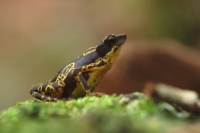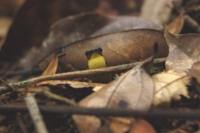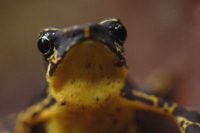Welcome to Atelopus.com
The Atelopus species live in the American tropics. During the last 20 years the populations have declined over most of their distribution range. In the last 10 years several well studied populations that have gone extinct from nature, for example the golden frog (Atelopus zeteki) that we chose to use in our logo. There is a combination of reasons for the disappearing of these frogs but the main reasons are the loss of habitat, disease, pesticides and climate change. It has been told that of the 113 harlequin frog species of Central and South America, at least 30 have vanished in the last 20 years. Also 81 percent of the adequately studied species are in decline because of the above mentioned reasons. Besides all this bad news it should also be told that there are probably many more species of Atelopus that haven’t been discovered and/or described until this day.We want to try and expose a little bit more about these wonderful forest-dwelling neotropical toads, called harlequin frogs, to the world. By spreading more information about them we might hopefully be part in helping the world to be aware of this genus of species that is disappearing. Letting people know more about these animals might be a step in getting help for them to survive in the wild.We hope you’ll enjoy the photos and information on this website.
Monitoring Atelopus
Atelopus Pulcher
Monitored by: Dennis Nilsson (Sweden), Remco Stuster (Netherlands), Josh Richards (Peru).
Date: July 21, 2019
Location: Cordillera Escalera, Peru
Population status: Critically Endangered
One female individual found.
Atelopus Pulcher
Monitored by: Josh Richards (Peru)
Date: April 2, 2018
Location: Cordillera Escalera, Peru
Population status: Critically Endangered
Josh lives in Tarapoto Peru and have seen Atelopus pulcher regularly in the Cordillera Escalera. In the past month, they have seen 6 animals and he saw a 7th animal late last year. The population seems to be slowly coming back. We all hope he is right.
Atelopus laetissimus
Monitored by: Dennis Nilsson (Sweden), Remco Stuster (Netherlands), José Louis Perez-Gonzalez (Colombia)
Date: July 2017
Location: San Lorenzo, Sierra Nevada, Colombia
Population status: Stable but chytrid is present
Atelopus nahumae
Monitored by: Dennis Nilsson (Sweden), Remco Stuster (Netherlands), José Louis Perez-Gonzalez (Colombia)
Date: July 2017
Location: San Lorenzo, Sierra Nevada, Colombia
Population status: Stable but chytrid is present
Atelopus laetissimus
Monitored by: Dennis Nilsson (Sweden), Remco Stuster (Netherlands), José Louis Perez-Gonzalez (Colombia)
Date: July-Aug 2017
Location: San Pedro, Sierra Nevada, Colombia
Population status: Stable but chytrid is present
Atelopus carrikeri
Monitored by: Dennis Nilsson (Sweden), Remco Stuster (Netherlands), José Louis Perez-Gonzalez (Colombia)
Date: July-Aug 2017
Location: Páramo de Cebolletas, Sierra Nevada, Colombia
Population status: Stable but chytrid is present
Atelopus certus
Monitored by: Angel Sosa, Panamá
Date: Spring 2011
Location: Cerro Sapo, Darien
Population status: Stable but might be the next victim for the chytrid infection.
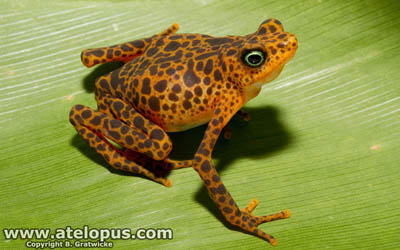
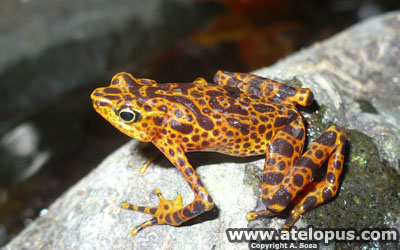
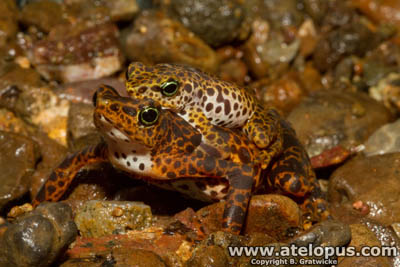
More information about Atelopus Certus is available here.
Atelopus crucíger
Monitored by: Manuel Guerreiro (Venezuela).
Date: Spring 2009 (May 30)
Location: Henry Pittier (South of "Ciudad de Cata")
Population status: Critically Endangered although stable in numbers.
Other info: This population was discovered less than a decade ago, after not having been seen since 1986
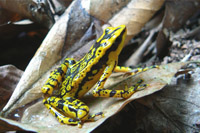
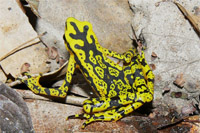
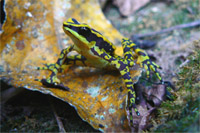
See also this link for more information about populations
Atelopus sp. 'Hoogmoedi'
Monitored by: W. Cattersel (Belgium).
Date: Spring 2009
Location: Brownsberg - Surinam
Population status: healthy
|
|
|
|
See also this link for more information about populations
Last year observed
This is a list that we try to keep updated with help from reports that has been sent to us. There is no guarantee that these animals has not been observed just because we havn't added something in the list. A missing observation means that we havn't had it reported, or that the observation has been too weak or doubtful for being added. Click here to see the list.
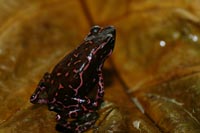
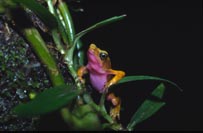
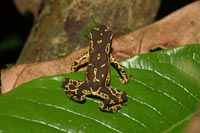
- New observations of Atelopus pulcher has been added to the lists.
- Don't forget to report your observations also!
- Tip! Please have a look at these wounderful species:
> A. reticulatus
> A. glyphus
> A. certus
> A. chiriquiensis
> A. oxapampae
> A. sorianoi
Our Motivation
The Atelopus are disappearing rapidly in Latin America and we, in the role of frog-lovers, would hate to see them disappear from their natural habitat. We have build this website to get more attention for these lovely beings and we hope to get more people to recognize this problem. Let's hope this website is not the last place where you can see the Atelopus species in the future.
Monitoring Atelopus
It's interesting to know about how the status is of the diffrent Atelopus populations. If you have been in a population recently or at least later then published here, please tell us. We will publish the recieved information, photos or just the latest seen list.
If you have any information that you want to share, please e-mail us





